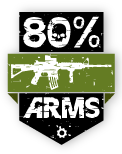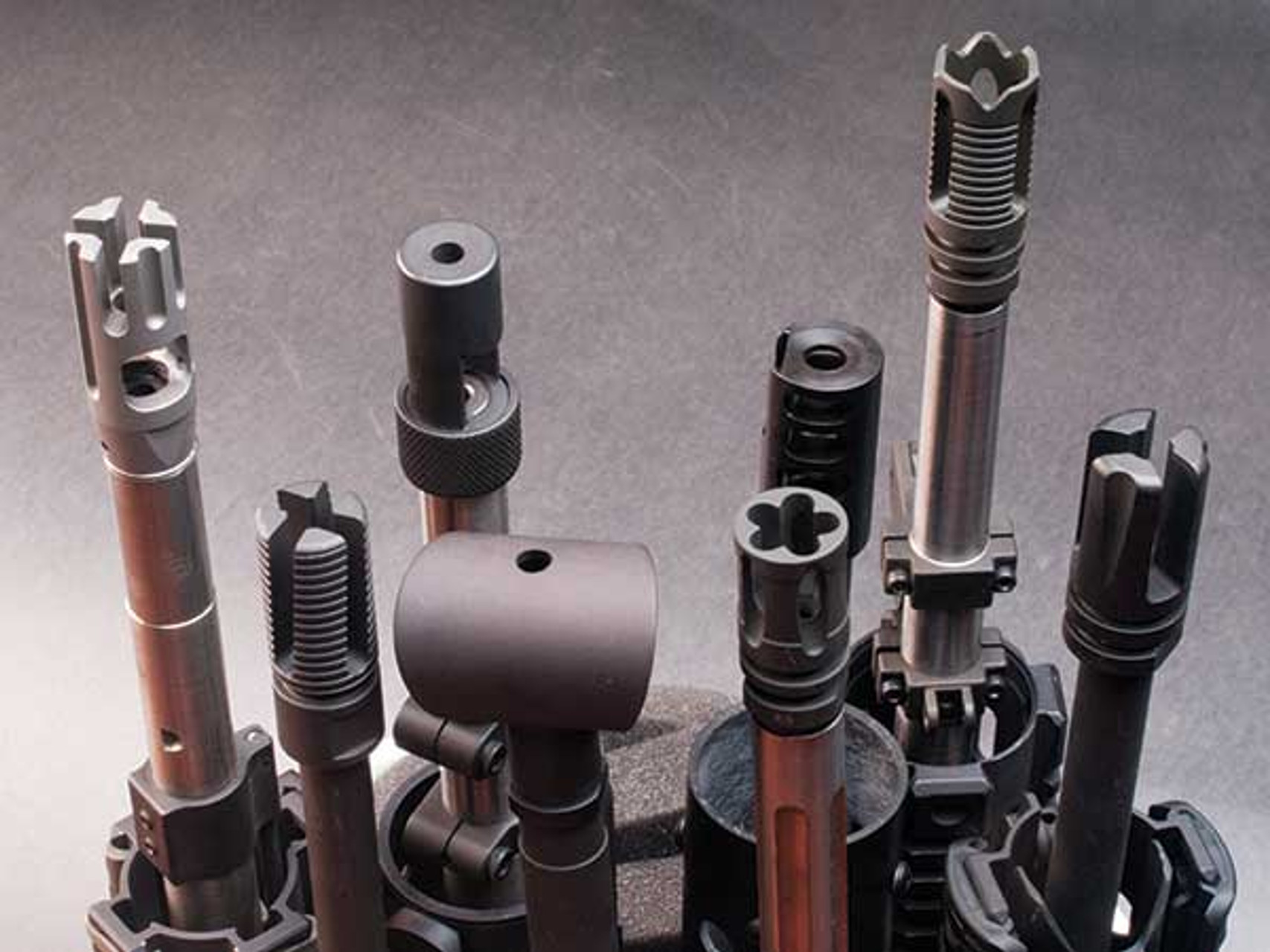Muzzle brake vs Compensator vs Flash Hider
*Update: This blog has been updated to reflect more accurate information in 2022.
One of the most common mistakes made in the gun community is referring to a magazine as a ‘clip’ , but a very close second is confusing a muzzle brake, flash hider, and compensator. Let's discuss what exists in the world of AR15 muzzle devices. There are several different AR 15 muzzle device types that help you achieve a desired effect in making each shot as efficient as possible for your AR build.
Some may not know the difference between these muzzle devices, have incorrect information or just may not see why it matters. Despite looking similar, they serve very different purposes and can range in price anywhere from $20 to $150 or even more. Among the wide variety of muzzle devices there are muzzle brakes, compensators, flash hiders, blast forwarding devices, suppressors and even suppressors training devices. So what's the difference?
Do I need a muzzle brake?

Muzzle Brakes come in many shapes and sizes, with vary degrees of effectiveness and price.
Also incorrectly referred to as a compensator, a muzzle brake is a device connected to the end of a barrel that redirects a portion of the propelled gasses to combat muzzle rise, linear movement and some perceived felt recoil. A good way to understand muzzle brakes is to look at Newton’s third law: for every action, there is an equal and opposite reaction. Muzzle brakes direct gasses up, to the sides, or backwards in order to achieve the prior goals, typically making the brake extremely loud so be sure to wear ear protection.
There are even adjustable muzzle brakes on the market that allow you to finely tune your device to your preference. One product example comes from the Godfather of the AR world — Armalite came out with their M-15™ TUNABLE COMPETITION MUZZLE BRAKE and with pricing at $139.00, it’s pretty on par with most adjustable devices. If you prefer something you don’t have to work on while on the range, we really like Aero Precision’s Gamma 556 Muzzle Brake that takes the guesswork out of tuning.
Muzzle Brake Pros
- Slightly lightens recoil impulse
- Significantly reduces muzzle rise
Muzzle Brake Cons
- Can be expensive
- Creates a concussive effect for fellow shooters that are nearby
- Absolutely not ideal for indoor use
- Can shoot gas back towards the user
- Can be extremely loud
- Almost guaranteed to give off flash signature from every shot
Do I need a flash hider? 
An example of how widely Flash Hiders can vary in design styles
There is this misconception that muzzle flash is the result of unburned powder. What that flash actually represents, is extremely hot gasses (usually around 3,600 degrees) expanding rapidly when meeting cooler, ambient air. These hot gasses leave the end of the barrel and create a sort of bubble effect. So the ‘flash’ that we see is actually this gas bubble becoming incandescent and briefly crossing the visible spectrum. In simpler terms; hot gasses make bright lights.
In order to negate this burst of visible light, flash hiders create turbulence. By blending the hot gasses with cooler ambient air in a disruptive pattern, there can no longer be a large bubble to glow and the gas is dissipated in smaller sections.
If you have an ‘off the shelf AR15’ you more than likely have an A2 flash hider, commonly referred to as a ‘birdcage’ design. This flash hider is the most common design you’ll see and is the standard for rifles used by out military. The bottom is solid to prevent you from creating a dust signature when firing from the prone position, and it is an overall acceptable flash hider. However, it doesn't provide stellar results which is to be expected from the government's "limited" budget. For whatever reason that someone intentionally wants to buy or use an A2 flash hider, they can be picked up for as little as $10, making it the cheapest option by far in the realm of muzzle devices.
Flash Hider Pros
- Helps to keep your rifle fire concealed at night.
- May aid in slight muzzle-rise reduction.
- Typically the most affordable option.
Flash Hider Cons
- Does not mitigate muzzle rise at all.
- May not be effective on shorter barrels.
Do I need a compensator?

Compensators like this one from ODIN Works look pretty mean too.
A compensator, much like a muzzle brake, is designed to reroute expelled gasses in order to achieve less recoil and muzzle movement. Whereas the brake tends to aid greatly in reducing both recoil and muzzle movement; the compensator focuses on reducing perceived felt recoil in a way that's a huge upgrade than a flash hider but it may not be as effective as a muzzle brake in reducing muzzle rise.
The reason for this is because compensators will redirect gasses less aggressively that brakes so that the user and surrounding people won't get hit with a wall of gas as much if at all. Nevertheless, compensators are perfect for calibers that don't create a lot of recoil, helping the shooter stay on target for quicker and more accurate follow up shots.
Compensator Pros
- Helps dull out perceived recoil.
- Offers real-world benefits to real-world civilian shooters.
- There are many 'hybrid' designs that combine muzzle brake-like features as well.
- Not as loud as muzzle brakes.
- Won't get hit with a wall of gas when firing.
Compensator Cons
- Can be expensive.
- Doesn't reduce muzzle rise as much as muzzle brakes.
Blast Forwarding Devices
Less commonly known on the muzzle device spectrum are the blast forwarding devices or “flash can”. So what are they and why should we care? Well. I’m glad you asked. Blast forwarding devices or BFD’s allow you the use of a compensator or muzzle brake for control, the BFD covers the other device and directs the remaining gas forward and away from the shooter. This is particularly convenient when shooting a rifle cartridge through a pistol or SBR length barrel. The BFD will direct the gas and unburnt powder down range away from your face.
Using a Blast forwarding device doesn’t take anything away from your muzzle brake or compensator. It is simply a directional device that works in conjunction with others to give you the control without a face full of gas or powder. Products such as the Indian Creek Blast Forwarding Device work with other devices that are 1 inch in diameter or smaller. Whereas, some products like the Lantac Blast Mitigation Device will exclusively work with their own company's muzzle brake, the Lantac Dragon.
BFD Pros
- Allows for the use of a compensator or muzzle brake.
- Directs gas out and away from the shooter.
BFD Cons
- You must either use a muzzle brake or compensator that is manufactured specifically for your BFD or find one that will allow for Universal use.
Suppressor Training Devices
What are suppressor training devices and how are they useful?. If you're in the market for a suppressor but have never used one before, here’s a little hint, they make your rifle 5 to 10 inches longer and slightly heavier at the front. I know that sounded like common sense, but it easily overlooked when the coolness factor comes into play.
This can become an issue if you are doing any CQB training or Executive Protection from a vehicle. Nobody wants to knock their muzzle on a wall or door or get hung up by a seatbelt while exiting a vehicle. Since suppressors do have a shelf life and are quite expensive to replace, it's a good idea to get the hang of maneuvering and firing with something cheaper while still providing the fit and feal of a firearm that’s actually suppressed. Surefire has the SOCOM FAST-ATTACH® SUPPRESSOR TRAINERS that work well as a training aid for their suppressors.
Here’s one more tip, since they are training devices and not functioning suppressors, you’ll still need hearing protection. Again, I know it seems obvious but that’s the world we’re living in.
Trainer Pros
- Get the feel of a suppressed rifle for training.
- Cheaper to replace than a legitimate suppressor.
Trainer Cons
- They can be every expensive.
- Doesn't actually do much for your shooting performance or hearing protection.
Which Muzzle Device Should You Go With?
The differences are pretty few and very clear. A flash hider tries to disrupt as much gas as possible, while the brake wants to reroute gas to control a recoil impulse. Flash hiders may help minimally with reducing recoil, but mainly just hides flash from the naked eye. Muzzle brakes actually tend to increase flash as well as noise, while greatly minimizing recoil and muzzle flip. Some devices, like the SureFire WarComp will incorporate both features into one device. It won't be the best in either category, but still offers you a pretty good compromise.
The question you need to ask yourself when choosing your muzzle device is “what is my intended purpose?” Do you do a lot of nighttime hunting? You may want to consider a flash hider to preserve your vision at night. Not your situation? A muzzle brake or compensator will help with accuracy, follow up shots, and recoil — all of which are very important. The flash hider, well, it mostly just helps to hide your shots from bad guys but there are good reasons to use some three prong flash hiders sometimes too!
Get your next muzzle device from 80 Percent Arms!
Always be sure you are purchasing a device that fits the threads of your rifle. Most MilSpec AR-15 rifles are the same, but you’ll find some that may have a different thread pattern or left hand threads. If you’re an AK style rile kind of person, you may have to search a bit deeper especially if your rifle is of the 100 series with 24x1.5 monstrous threads. There are so many products on the market to enhance your shooting ability from muzzle to butt stock, you just need to find the right parts to fit our needs.
A great place to start the search for the perfect AR-15 is with a solid base like the Type III Hard Anodized Billet AR-15 80% Lower Receiver, a true ambidextrous lower that can be accessorized to the max to fit all shooters of every skill level! Get yours today and genuinely build the ideal rifle from the ground up!



 Back to List
Back to List